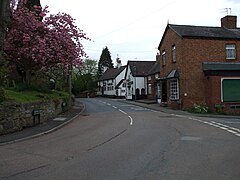Hampton-in-Arden
| Hampton in Arden | |
|---|---|
 Hampton in Arden, High Street |
|
| Hampton in Arden shown within the West Midlands | |
| Population | 1,834 (2011 Census) |
| OS grid reference | SP205815 |
| Civil parish |
|
| Metropolitan borough | |
| Metropolitan county | |
| Region | |
| Country | England |
| Sovereign state | United Kingdom |
| Post town | Solihull |
| Postcode district | B92 |
| Police | West Midlands |
| Fire | West Midlands |
| Ambulance | West Midlands |
| EU Parliament | West Midlands |
| Website | Welcome to the website for Hampton in Arden |
Hampton-in-Arden is a village and civil parish in the Metropolitan Borough of Solihull, in the West Midlands of England. Hampton-in-Arden was part of Warwickshire until the 1974 boundary changes. It is in countryside between Birmingham and Coventry. Hampton-in-Arden is a typical Arden village, but is now very much a commuter development for nearby Birmingham, Solihull and Coventry. In 1968 the central part of the village was designated a Conservation Area, which is an "area of special architectural or historic interest, the character or appearance of which it is desirable to preserve or enhance". Its population in the 2001 census was 1,787, increasing to 1,834 at the 2011 Census.
Hampton is mentioned in the Domesday Book, when it was held by Geoffrey de Wirce. "In Coleshill Hundred Hantone. 10 hides. Land for 22 ploughs. In lordship 2; 2 male and 2 female slaves. 50 villagers with a priest and 16 smallholders have 13 ploughs. A mill at 40d; meadow, 10 acres; woodland 3 leagues long and 3 wide. The value was and is 100s." All of Geffrey's lands were held freely by Leofwin. Geffrey's wife was called Aelfeva and her English name suggests that Geffrey may have acquired his Warwickshire lands through her, by inheritance rather than by confiscation; she may have been Leofwin's heiress. A priest was recorded, implying that a church existed.
Of the name, Hantone, Dugdale states that the name was occasioned from the situation, "hean" in the Saxon signifying high though by contraction written "han" and through corrupt pronunciation "ham".
Dugdale could find no mention of Geffrey having any children and concluded that he must have died without issue, his lands reverted to the Crown and by a grant of Henry I all his lands were passed to Nigel de Albani. Nigel had a son, Roger, surnamed Mowbray, from whom, from the middle of the 12th century the de Ardernes, became the Lords of the Manor. Afterwards it passed by marriage to the de Montford family of Coleshill and then subsequently reverted to the Crown. It was granted to Robert Dudley, Earl of Leicester, by Queen Elizabeth I in 1570 but reverted to the Crown after his death. In 1625, it was assigned to Queen Henrietta Maria, wife of King Charles I. In the early 19th century it was sold to Isaac William Lillingston who later sold the Manor of Hampton to Sir Robert Peel (former Prime Minister and founder of the modern police force). On Sir Robert's death in 1850, the manor was inherited by his son, Frederick, who did much to 'modernise' Hampton, demolishing many half-timbered and thatched cottages. He employed the architect W E Nesfield to build new dwellings, shops and lodges.
...
Wikipedia

